I had a really long post ready for this year's BlizzCon but instead I just sum up my frustrations with Blizzard by posting something that long-time gamers remember about the company. There was another game system that existed more than a decade before Blizzard's two biggest hits. These games were the inspiration for Blizzards success yet they rarely get coverage in the gaming media.
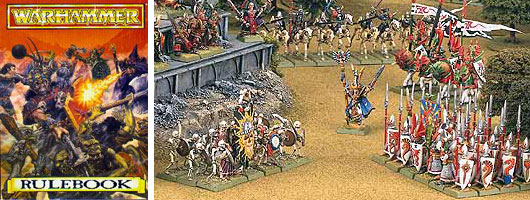
Warhammer Fantasy Battle, or Warhammer for short was first published by Games Workshop in 1983. It was a tabletop gaming system by set in a world that was similar to the Dark Ages. There were knights and kings, damsels and dragons. Games Workshop developed the rules for playing as and against the various classes. Citadel was their miniature studio and they created the figures for gamers to collect, assemble, paint and customize.
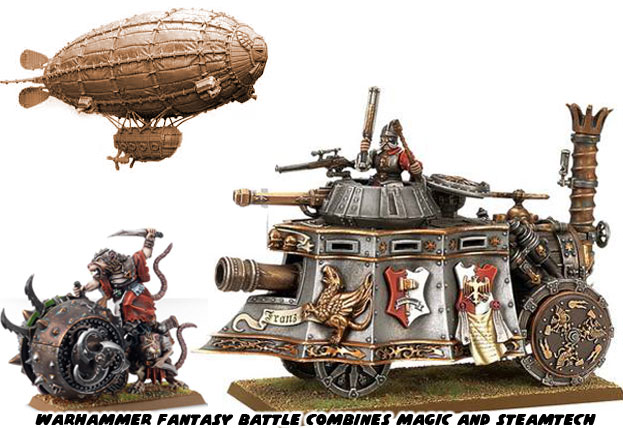
The universe of Warhmmer was not simply a fantasy version of medieval England. Magic existed but so did some steam machinations and lighter-than-air craft. It was as if the Jules Verne inventions were placed centuries earlier. There were sailing ships as well as some steam-powered ships. There were even submarines and machines that drilled through the Earth!
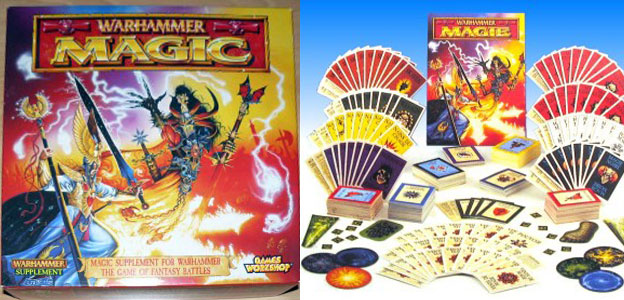
There were towers that gathered the sorcery "winds" and fortresses that floated on currents of magic. This mix of magic and technology was unique to the genre. It made the characters that lived within the world much more unique than those of our own ancient world. There were two large human kingdoms in Warhammer, those of
Bretonnia and the
Empire. The Bretonnians were similar to Medieval England. This was a kingdom of magic, dragons and knights. It had a heavy emphasis on the Arthurian legends.
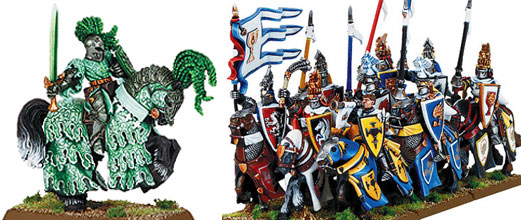
The Empire was an amalgamation of Germanic and French provinces in their universe. The Emperor of the ancient world, at this era was known as Karl Franz, he held Ghal Maraz (dwarf for skull splitter) the actual "warhammer" that the game was named after. Some of the heroes in the universe rode horses, others rode lions, bears, unicorns and gryphons. Those that think WarCraft invented fantastic "mounts" were sorely misinformed.
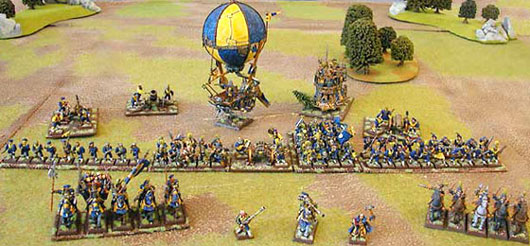
Humanity formed alliances with the
dwarf and
elf kingdoms during the early wars of survival. These were the precursors to the heroic "Alliance" in World of WarCraft and of course all of the evil races went into the "Horde."

In the Warhammer universe the evil forces usually fell under the banner of Chaos but there were also evil races that had nothing to do with Chaos as well.
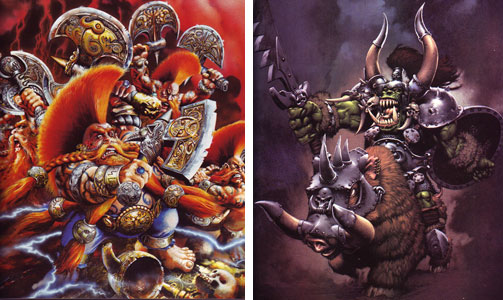
Orcs and goblins also inhabited the world of WH. The designs of these "greenskins" was possibly the single thing most copied over the next 30 years. I know that Games Workshop did not invent the orc, hobgoblin, goblin or troll. Those came from various legends from around the world. The descriptions of these monsters was fairly well known. The creatures were brutish, with leathery green skin and sharp teeth. Some lived in swamps and marshes, some could spit poison and even control the creatures of the night.
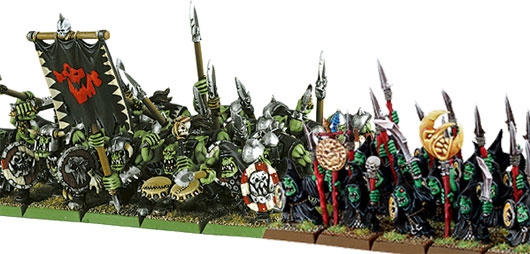
What Games Workshop did do was popularize the designs. In essence most orcs and orc variants that you see in video games were based on Games Workshop designs. The scale and proportions of the heads and bodies varied depending on which studio produced the art.
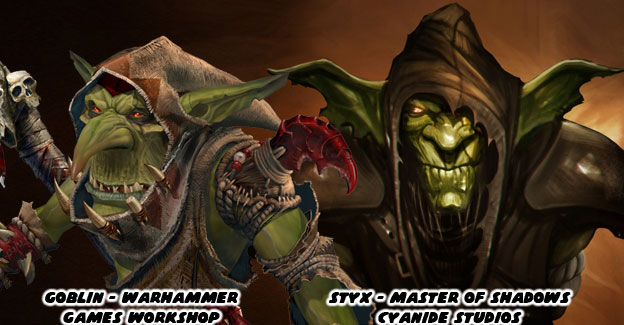
Take for example the stealth game Styx Master of Shadows. The game by Cyanide Studios did a great job of combining the stealth gameplay and exploration of Assassins Creed to the fantasy design of Games Workshop. It was no coincidence either, Cyanide Studios developed the Blood Bowl PC games which were based on the Games Workshop's fantasy football game.
Aesthetically the creatures in WarCraft were very reminiscent of those from Warhammer. If anything they were made slightly simpler. Side by side here was art from Games Workshop and Blizzard, you tell me if there were any similarities.
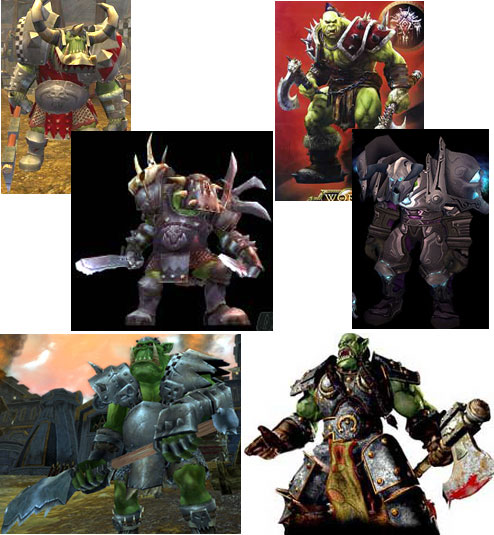
Aside from the classic fantasy characters there are also creatures unique to the Warhammer world. One of the evil races occupying the world are mutated, highly-intelligent rats known as Skaven. The
Skaven could be considered the mechanical equivalent of the industrious dwarfs. They did not use fossil fuels or steam for their machines. Their diabolical inventions ran on green radioactive "warpstone." This poisonous stone caused almost as much damage to the Skaven as the creatures they attacked.
Surprisingly enough Blizzard did not poach the Skaven designs, somebody else did. Rat-like characters named "Whiskers" armed with poison green weaponry had popped up in designs by comic book artist Joe Maduera for a video game called
Dungeon Runner. Below are the Skaven miniatures compared to the Whiskers concept art. Coincidence?
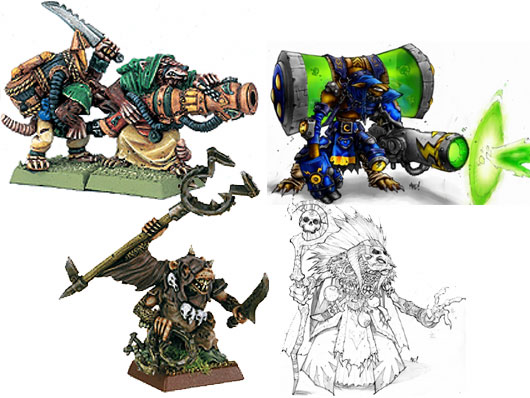
The other great contribution that Games Workshop had to fantasy design was with the development of the
chaos warriors. These misshapen men, women and creatures were representatives of the chaos gods. They were similar to the Four Horsemen of the Apocalypse from biblical verse. There were chaos gods that identified with war or pestilence, they reward faithful subjects by turning them into demons and giving them magical powers. The miniatures for these chaos warriors were among the best ever sculpted. Accordingly, when Games Workshop was firing on all cylinders they were also the best painted in the world.
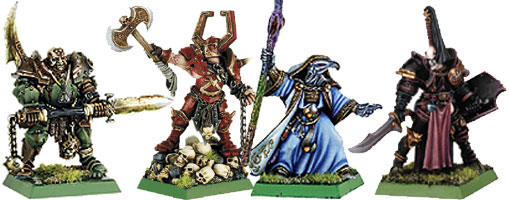
Among the oldest tribes in the WH world were the
Slann, later renamed the Seraphon. These reptile creatures lived in a part of the world similar to pre-Columbian America. True to form this meant that the architecture and weaponry employed by the Slann was reminiscent of Aztec and Mayan culture. The Slann were known for their very powerful mages, among the most powerful magic creatures in all of Warhammer.
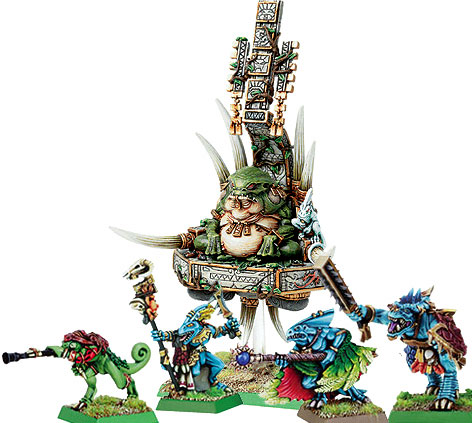
WarCraft didn't poach the Slann or Skaven but instead looked at other animals, like bulls or Tauren, on which to create a race on. The Chaos soldiers were often corrupt humans but almost every race in Warhammer had an evil opposite. There were
Dark Elves (called Night Elves in WarCraft), and Chaos Dwarfs that fought against their noble kin. There were are also armies of the undead, led by the
Vampire Counts.
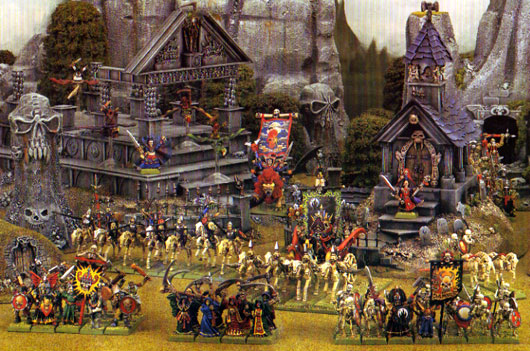
What was interesting to notice is the evolution of the armies in Warhammer. The system did not stay the same over the years and evolved quickly. In order to keep players interested the system had to keep expanding and introducing new races and quests. The same things that World of WarCraft would do in order to keep subscribers engaged. For example early skeleton armies were controlled by Necromancers and Vampire counts. While the classic skeletons were still around, new dedicated skeleton armies were controlled by ancient Pharaohs or
Tomb Kings from the south had been introduced to the world.
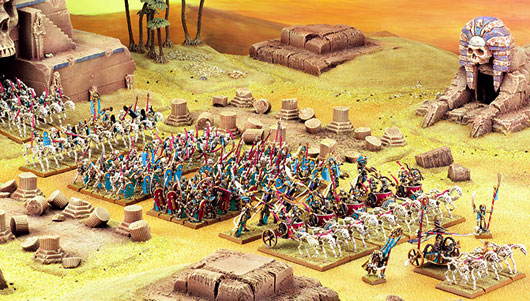
Through the '80s Warhammer was great fun and limited only by your imagination. For those that were into a more traditional role-playing experience, Games Workshop also offered a
fantasy roleplay system set in the Warhammer universe. If, however your imagination was running on empty then the hobby tips provided in White Dwarf magazine (also published by Games Workshop) could inspire you.
One of the best features that Games Workshop built into the game were adding ship combat to the universe. This was years before naval combat had existed in any MMO, and especially before WarCraft. The articles in White Dwarf included
how to make your own ship,
custom ship ideas as well as sample campaigns.
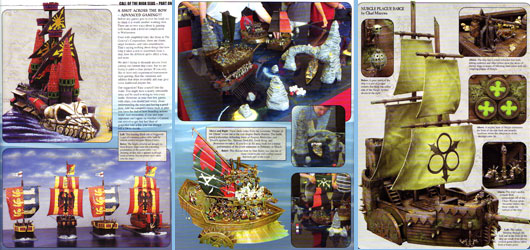
To top it off White Dwarf even published rules for using sea monsters with the ship game and how to model these monsters yourself.
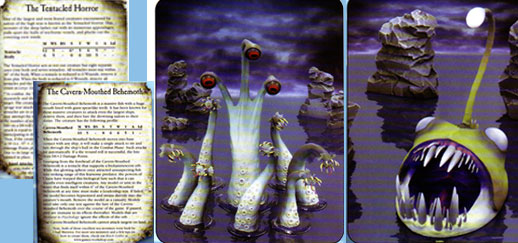
Now take a step back and look at the big picture. How long had this gaming system been around? What was it like to see the various races fighting for power? Each race with its own strengths and weaknesses. Its own special units, magic, heroes and tactics. Imagine these armies clashing in a tabletop war. Hundreds of brightly painted characters smashing each other in glorious combat. Imagine what it must have been like to witness these games 25 years ago as a budding game programmer, designer or artist. Squint your eyes if you have to. Is this starting to look like the original Warcraft RTS game?
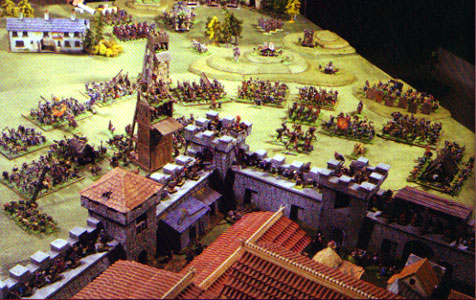
Games Workshop developed rules for controlling units, what bonuses they received when equipped with the right weapons or controlled with the right leaders. In the video game these things became known as "buffs." Games Workshop figured out effective ranges for each type of fighter and squad and more important, figured out how to keep the armies balanced out. A solid strategy and a few good dice roles could help ensure victory.
What Blizzard did was adapt those rules, those ranges, unit types, bonuses and random dice roles and turned them into a PC game engine. This made things a lot easier for people that did not want to measure out the strikes of their units using a ruler, for those that did not want to read all of the rules of engagement or figure out if line-of-sight was in effect when battling. Instead fighting a battle was done with the press of a few buttons and the virtual armies moved themselves on the battlefield.
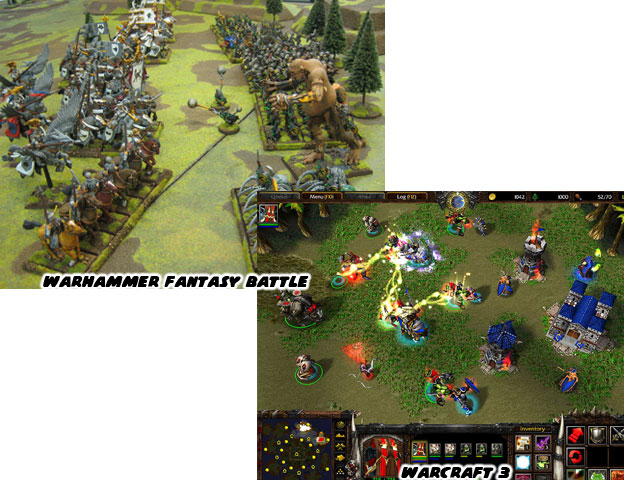
There was no doubt that Warhammer was influential on the development of WarCraft. Sadly none in the game press bothered to call out Blizzard for these similarities. But more shocking was how a few years later Blizzard released StarCraft. This was a science fiction RTS game that swapped out knights for space marines and introduced aliens instead of fantasy creatures.
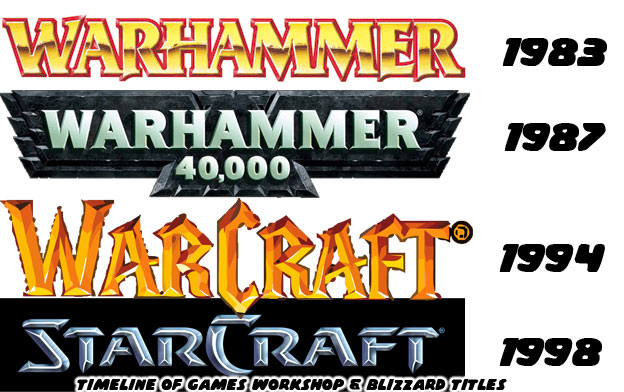
Games Workshop released Warhammer 40,000 in 1987. It was set in the far future and featured Space Marines battling all sorts of alien lifeforms across the galaxy. The original monsters in the game were simply space versions of fantasy characters. The Elves became Eldar, yes, there were Dark Eldar as well. The Orcs became Orks and still used crude weapons and machines in battle.
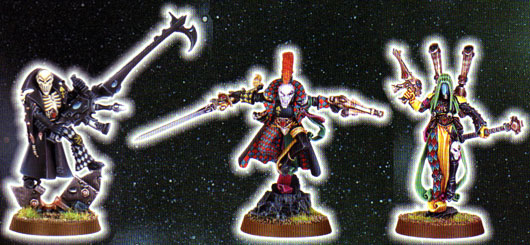
StarCraft debuted in 1998, more than a decade after Warhammer 40,000 or 40K for short. Blizzard pretty much poached the concept that worked for WarCraft and set it in the future. What was shameless was how much one of the "new" alien races looked like a Games Workshop one.
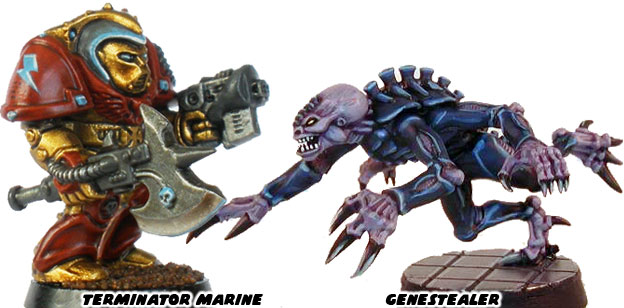
The Genestealers, which to be fair were poached from the Alien movie, were released in 1989. They were the new 40K aliens featured in the game Space Hulk. The Genestealers would become the shock troops for an alien race called the Tyranid. These clawed creatures appeared in 1990 in the Advanced Space Crusade adventure. The Tyranid were without a doubt the basis for the Zerg aliens.
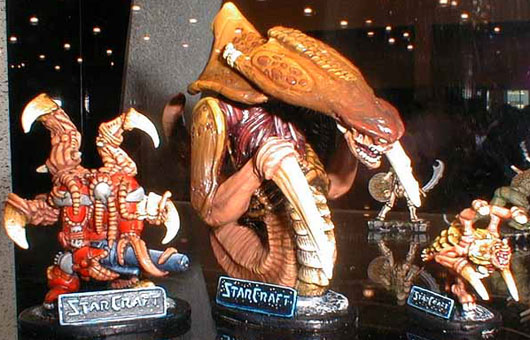
In shameless style Blizzard had the audacity to announce their own miniatures for a tabletop gaming system. Of course every miniature they unveiled looked eerily similar to one released by Games Workshop years earlier.
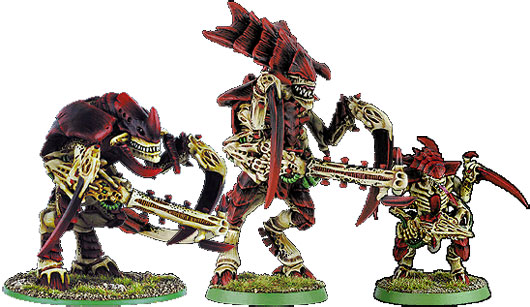
Above were some 40K minis including Imperial Guard, Space Marines, Space Marines in Terminator armor and Sisters of Battle. Blizzard had the nerve to do the same thing for the alien species in StarCraft as well.

Maybe when I put the Tyranids after the Zergs you might notice the similarities.
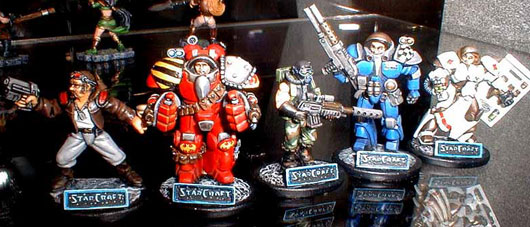
There were other aliens in StarCraft though. The blue-skinned Protoss for example.
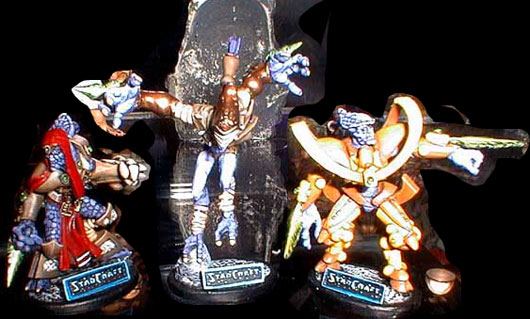
To be fair though Blizzard did have the Protoss in their games four years before Games Workshop introduced the Tau and Kroot warriors. The Necrons however (robotic skeletons controlled by alien Pharaohs) were as old as StarCraft.
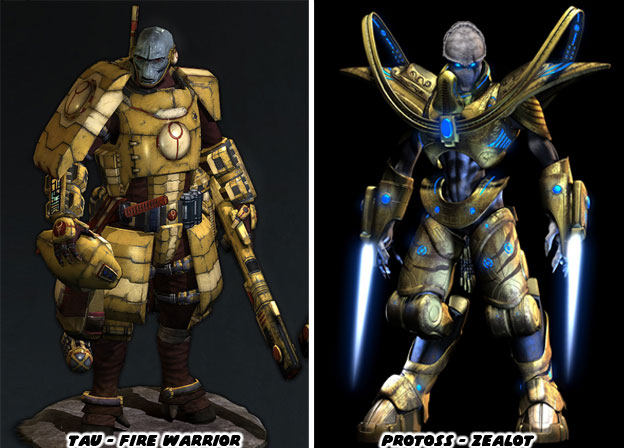
The inspiration for the Tau was based on feudal Japan, with the weapons and vehicles based on mecha. The code that the aliens lived by was somewhat imperialistic but could also be highly religious. It was as if great technology was still governed by ancient scriptures. Similar things could be seen in the Protoss aliens.
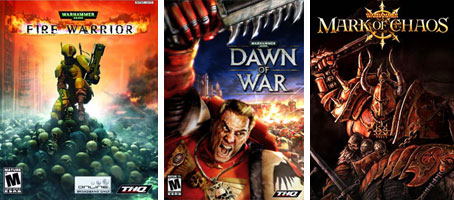
Too bad Games Workshop had nothing but crappy video game licenses up until now or else the world of video gaming would be very different. Not that it matters, the damage was done and Blizzard made billions of dollars off the ideas of another company.
Now that Blizzard was a huge publisher they could hire all sorts of artists, programmers and designers and no longer have to poach the ideas of another studio. Especially not a French tabletop gaming company named Rackham that went toe-to-toe with Games Workshop in the early 2000's, right?
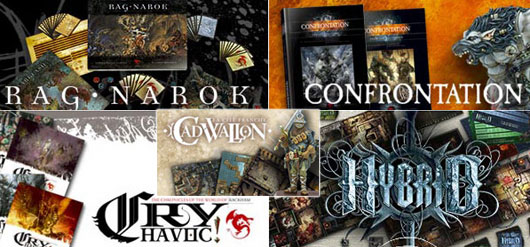
I mean maybe it's a coincidence that the new shooter Overwatch has different alien archetypes mixed with Western and Eastern heroic designs. It was just coincidence that the Reaper and robotic Reinhardt were reminiscent of designs from outside studios.
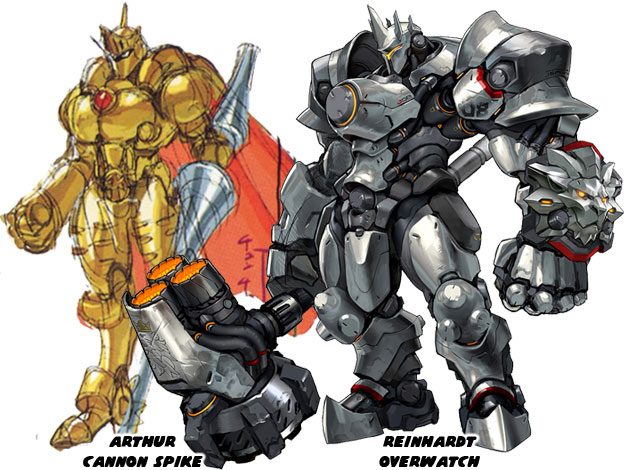
Arthur from Cannon Spike, how many Capcom fans had even played that game from 2000? Many gamers could guess that Overwatch was Blizzard's answer to the smash hit game Team Fortress 2. There were various classes of shooter, each with their own strengths and weaknesses.
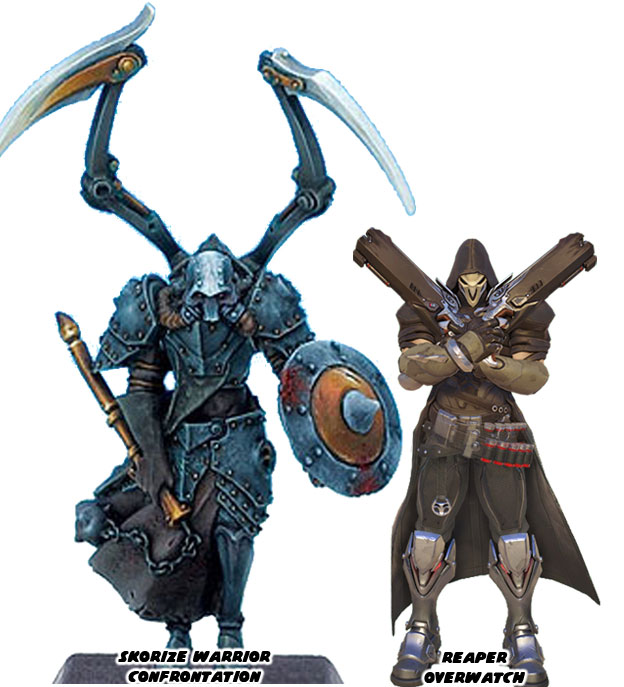
To mix things up Blizzard introduced robots, aliens and cyborgs into Overwatch. In this way they could never be accused of poaching the classes from Team Fortress. Where else could you play as a genius with an unorthodox weapon? That character certainly doesn't exist in Team Fortress 2...
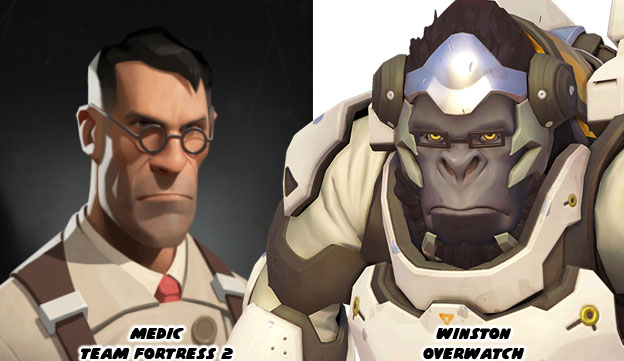
Of course an ape in power armor looks great in any setting but I would have been more impressed if the design for Winston did not poach the designs of the Karman alien characters from AT-43. It was a Rackham Studios game from 2007.
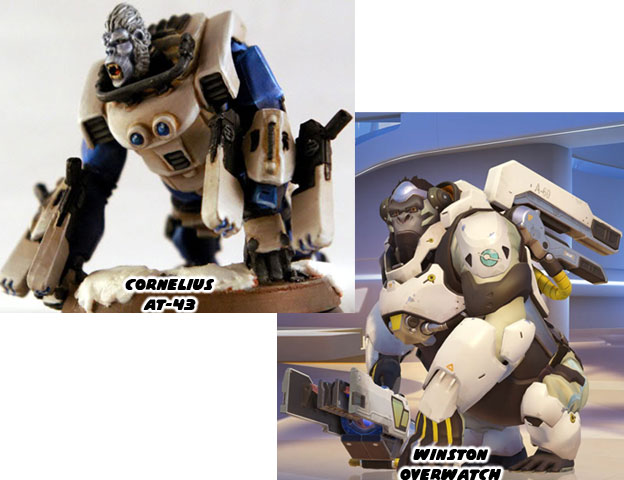
Rackham released the game AT-43 as a rival to Warhammer 40,000. A few years prior they had released Confrontation as their rival to Warhammer Fantasy Battle. AT-43 was a well designed system and not without its own subtle humor. The Karman were highly intelligent ape-like creatures with art deco-styled vehicles. As ferocious as they were they were also meant to be a jab at the Space Marines. They were big, brutish and carried all the heavy weapons into battle. In 40K the Space Marines were sometime big and brutish, they were genetically modified humans, much taller and stronger than ordinary people.
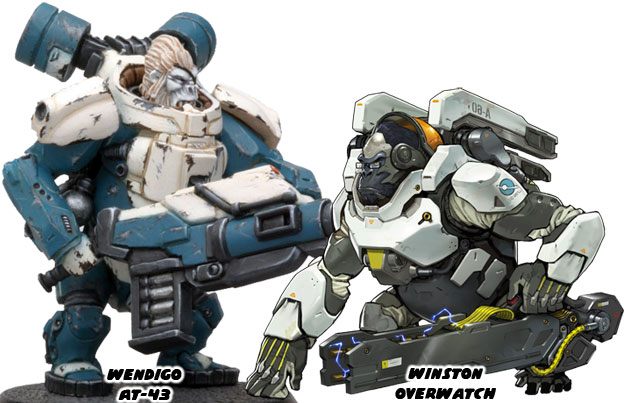
The humans in AT-43, those of the U.N.A. were meant to be compared to the Imperial Guard soldiers from 40K. Humans in both systems were the ones that had access to the tanks and artillery while the Space Marines did most of the fighting up close with their bolt guns.
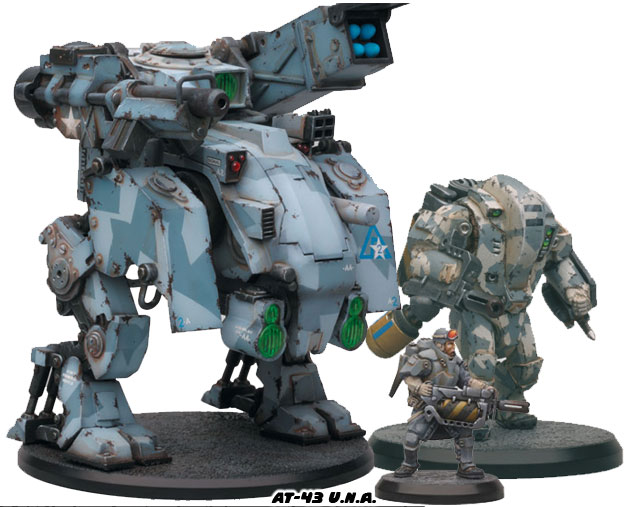
The Karman were fantastic aliens and the miniatures released on them were some of the most memorable ever created. If you did not follow the tabletop gaming scene then you might not have known. I'm sure Blizzard thought that they could get away with poaching some more characters for their new game. They had done it in the past and would probably keep on doing it. It's not like any game journalist would ever call them on it, right? I’d like to hear about it on the comments section. As always if you would like to sponsor me
please visit my Patreon page and consider donating each month, even as little as $1 would help make better blogs and even podcasts!





































You might also recognize the Overwatch character D.Va in this 2006ish or so SodaPop Miniatures figure, https://redmetalpanic.files.wordpress.com/2009/12/malya.jpg?w=500&h=500
ReplyDeleteMechalobster, good eye! Thanks for finding that one.
Delete